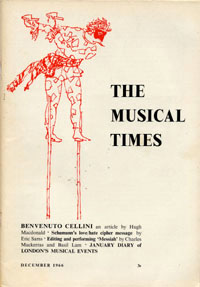
THE ORIGINAL ‘BENVENUTO CELLINI’
by
Hugh Macdonald
© 1966-2012 Hugh Macdonald

 |
THE ORIGINAL ‘BENVENUTO CELLINI’by Hugh Macdonald © 1966-2012 Hugh Macdonald |
 |
Berlioz conducted a single performance of his ‘Benvenuto Cellini’ at Covent Garden in 1853; it will be revived there for the first time on Dec 15. Hugh Macdonald, who is editing the opera for the New Berlioz Edition, discusses its various versions, and the text to be used at Covent Garden.
Many operas have come down to us bedevilled by the attempts of their composers and others to revivify a sagging dramatic frame, to make the thing work. To pick one’s way through the resulting maze of cuts, versions, and changes of sequence is not always easy; to establish the cause of such changes is harder still.
Berlioz’s Benvenuto Cellini suffered this fate by reason of its disastrous failure at the Paris Opéra in 1838. Although the blame was generally laid on the libretto (the work of Barbier and de Wailly) there seems little doubt that it was the unorthodox and demanding music that alienated the Paris public. Berlioz himself believed that the libretto was at fault, and therefore made a drastic revision in 1852 when Liszt revived the work in Weimar. In this he was closely advised by Liszt himself (their correspondence discusses every detail) and guided by immediate practicalities: ‘Reduced in this way’, he wrote to Liszt, ‘the opera should not exceed the usual length of an opera in Germany. Furthermore, there will now be only two scene-changes.’1 This revised version, the ‘Weimar’ version, was later published by Litolff and accepted by Berlioz as the definitive text; the autograph,2 though revealing abundant traces of its former state, conforms with the revision.
Berlioz recognized with pride the extraordinary vitality of his score and longed to recapture the spirit under which it was composed. So it is not mere historical curiosity that prompts one to inquire about the original version; anything that Meyerbeer’s Paris rejected offers a challenge to our taste and intellectual receptiveness. Is there not something here that Berlioz despaired of putting across, in the face of the tastes and habits of his time?
We can examine the 1838 version in a number of sources. In 1913 J. G. Prod’homme made a comparative study of the two versions from the libretto published at the time of the first performance.3 His concern was with the dramatic changes made by Berlioz in the later version, and not with the fate of all the music thrown out in the course of revision. In this respect Prod’homme was gloriously blind to the work of his colleague Julien Tiersot, who had already made a long and detailed study of the early version in l905.4 Tiersot’s investigation was much more thorough, for he consulted a 5-volume MS score and a ‘Violon-Conducteur’ part of the entire opera kept with the orchestral material in the Opéra library, and attempted a musical reconstruction of the earlier version.
But we can delve back further still. After the opera’s trouncing reception at the first of only four complete performances, Berlioz was naturally anxious to salvage what he could. Although cuts had been made in rehearsal, he (and the director Duponchel) continued to cut away this and that, so that when the score was shortly consigned to the Opéra shelves it was considerably reduced in bulk. This seems to be the point at which the 5-volume score was made, as a record for posterity rather than as a working copy, for it contains none of the music indicated as cut in the orchestral parts.
Since cuts were mostly physically removed from the ‘Violon-Conducteur’ part, to reconstruct the music entirely we must go to the orchestral parts, where cuts were either pencilled or pinned over, or sewn up. To unsew these pages is to bring to light music of Berlioz’s prime buried for more than a century, and the assembly of the parts into score is an exciting process that one might liken to those children’s drawings where an outline emerges under the pencil’s shading. Many of the ‘roles’ (the singers’ cued-in parts) are in part autograph.
In terms of time we can go back further still. In the Archives Nationales is a dossier5 that records many details of the production, including a full list of costume and scenery expenses. It also includes a copy of the libretto belonging to the summer of 1838. The main interest of this libretto is the appearance of the Pope in place of the Cardinal, and in many interesting details that were omitted elsewhere. It is well known that the appearance on stage of the Holy Father in person was deemed unsuitable; the Commission d’Examen (Censure) also took exception to the chanting of Penitents in Latin, but decided on reflection to leave this ‘à l’appréciation de l’expérience’.6
Broadly speaking, the Weimar revisions were designed to speed up the denouement, which appeared to hang fire, by compressing the action of the last act. Thus the two tableaux of Act 2 became Act 3 by itself, and the two divisions of Act 1 became Acts I and 2. Although divided into three acts not two, the opera was materially shortened.
If we trace the original version through from the beginning, we at once come upon traces of revision and patching. The opening scene, after the overture, was a semitone higher, in D flat. It introduces Teresa and her father, the Papal Treasurer Balducci, and his grumbling motif (Ex 1). This charming piece of characterization cropped up all over the original version, but was cut down to two appearances only in the published score.

Balducci’s exit is a false alarm. He decides that a ‘bon sermon’ would not be out of place, and comes back to lecture Teresa in a 6-7 minute address, whose burden is ‘Ne regardez jamais la lune’. This survives unfortunately in very fragmentary form (a few cues and snatches in the voice parts and most of the 2nd violin, otherwise nothing) but is evidently to be classed with the developed arias in La Damnation de Faust. This is a sad loss since the setting that replaced it (and survived) is decidedly more trivial. This is a simple strophic setting making much use of the un-Berliozian device of inversion (see Exs 2 and 3) and littered with the rumblings of Ex 1.

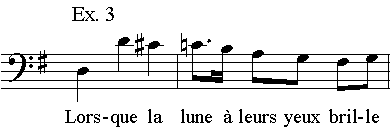
Teresa sighs with relief at her father’s departure, but the sound of the Chœurs des Masques in the wings brings him storming back. The Weimar version simply removed Balducci’s outraged cries, thereby losing a nice effect of contrast: as he goes to the window to find out what is going on, he receives a faceful of ‘fausses dragées’; he will have to go for his audience with the Pope looking like a leopard, he laments. After more protests he goes, and Teresa, going in her turn to the window, receives a bouquet thrown from below. We are here back in the Weimar version.
The cavatina that Teresa now sings belongs to 1838, but it is not what Berlioz originally wrote here. The earliest libretto gives some verses ‘Ah! que l’amour une fois dans le cœur’, whose setting was the music we know as the Rêverie et Caprice for violin. Madame Dorus-Gras’ role reveals heavy alterations, revisions of the vocal line, and raising of the tessitura, many of them in Berlioz’s hand, so we may surmise that her dissatisfaction with this difficult piece compelled him to write a fresh aria in a more accepted operatic style. Whether the first setting was actually performed it is hard to tell.
In the first act, the only other major revisions occurred in the finale when the neighbours come in to hound Fieramosca out. In the Weimar version this finale is uncomfortably short, and the excitement is more telling when given time to generate. This lopped member contains some piquant harmonic clashes (Ex 4).

The second tableau of Act 1 (Act 2 in the Weimar version) begins with Cellini’s Romance ‘La gloire était ma seule idole’, which was written between Sept 3 and 10, 1838, after the postponement of the first performance, and does not therefore feature in the libretto of the time. The charming scene of the innkeeper that follows was cut during the performances of 1838 and the original version contains a chorus taking up with enthusiasm Cellini’s suggestion to go to Cassandro’s booth. In the second version the chorus have space merely for a perfunctory ‘Oui, vite, vite chez Cassandro’ before resuming the goldsmiths’ chorus.
Fieramosca’s ingenious fencing aria is a mere shadow of its original self, for the parts contain some long additional passages. The music was originally, too, a tone higher, Fieramosca being then a tenor, and his name was accented on the last syllable.
The scene changes to the Piazza Colonna for the carnival. The first 20 bars of this scene are a Weimar addition. When the saltarello gets under way, we may allow Habeneck some of the sluggishness Berlioz accused him of in the Memoirs in the performance of this scene when we find the music written in 3/8; in the overture Carnaval Romain and in the Weimar revival, Berlioz removed every other barline. An interesting cut is found here in the parts, for at one point the music tripped into the falling fifths that Berlioz transferred to the Queen Mab scherzo of Roméo et Juliette (Ex 5). This was already borrowed from the discarded Ballet des Ombres of 1829. Since much of this section appears only in the choral parts it probably never got as far as an orchestral rehearsal.

The stage directions of the pantomime scene are only sketchily indicated in the score, and it is here that the early libretto is so illuminating. The parts also reveal intermittent stretches of discarded music. On p.210,7 for example, the curtain rises on a large money-bag crowned with a papal mitre placed on a throne. At the foot of the throne sits Balducci’s impersonator. Teresa, in a section missing from the Weimar version, tries to drag her father away from this potential source of embarrassment, but Balducci is determined to report to the Pope on how their authority is lampooned. The cadence on p.52 (bar 3) was enormously lengthened by a gross trill.
Harlequin and Pasquarello sing their numbers, the counterfeit Balducci yawns through Harlequin’s beautiful ariette, but beats time lustily to Pasquarello’s grotesque ophicleide and bass drum. The little scene that follows was suppressed in the later version but has a lot of charm. Harlequin receives a single gold écu for his singing (violins pizzicato) while Pasquarello is showered with coins (cellos, basses, bassoons); the two naturally come to blows. Balducci’s disgrace is complete.
It is the last act that shows the most radical revision and shortening, for the two tableaux out of which it was moulded were each as long as the total abridgment. The sequence of Act 2 Tableau I was as follows:
1 Entr’acte
2 Scene: ‘Ah! qu’est-il devenu’, chorus of penitents, and Cellini’s narration of his escape
3 Cellini-Teresa duet
4 Sextet
Cellini’s narration contains a few additional details of his escape, and a short blessing for his deliverance. The duet that followed had a long and beautiful introductory section in F sharp minor before the D major allegro, and this was even published in 1838 along with 8 other ‘morceaux détachés’ from the opera. The style of this part of the duet has much in common with the Rêverie et Caprice which we have seen also belonged to the opera, and the contrasting section gives the duet a sense of balance that more than makes up for its increased length.
The sextet is a full-scale operatic finale which was reduced by over a half both during and after the 1838 performances. Berlioz admitted: ‘the sextet is really too long; I shall shorten it as much as the text will allow.’8 53 bars disappeared before the entry of the Cardinal (Pope), and many later sections followed suit. One of these shows a different side to the Pope’s character with a lurching theme (Ex 6) which the woodwind frivolously invert. The crucial dramatic change is Cellini’s request, not for an hour in which to finish his statue, but a day, and the Pope grants it, brushing aside Balducci’s and Fieramosca’s protests. The scene ends with a vigorous ensemble in A major based on the melody heard previously (p. 285) to the words ‘Seigneur …’ ‘Réponds’.

During Cellini’s day’s grace a great deal more happened than in the shortened version. The final tableau contained a series of scenes that were removed provisionally in 1838 and permanently in 1852. But first came Ascanio’s aria ‘Tra la la’ (p.238) in which he describes the previous scene with the Pope instead of the events of the carnival which had to be substituted when the aria was put back before the sextet. Then Cellini sang his reflective ‘Sur les monts’ (p.298) free from the pressure of a one-hour ultimatum. This was followed by the workmen’s chorus ‘Bienheureux les matelots’ (p.232) with Cellini and Ascanio joining in with the lines later given to Francesco and Bernardino.
At this point the libretto went off at a tangent for a considerable time in a section Berlioz later described as ‘glacial et insupportable’. While the plot is perhaps unnecessarily complicated by this development, the music here was not without its qualities. Briefly, Fieramosca turns up and challenges Cellini to a duel at the cloister of St Anthony. Cellini, to Teresa’s horror, accepts, only to find that this was a ruse by Fieramosca to get Cellini out of the way so that he, Fieramosca, might bribe the workmen to defect. Teresa, however, seeing Fieramosca return, assumes that Cellini has been killed and rouses the workmen against him. Cellini returns and Fieramosca is forced to work in the foundry. This precedes the entries of Balducci and the Pope.
There is much of musical interest here. A great deal is made of the challenge ‘En enfer te faire descendre’ (Ex 7). Fieramosca’s fencing aria is recalled in a number of different forms, for instance when he has delivered his final challenge and he exits ‘en jetant des regards farouches’ to Ex 8 on bassoon and timpani. He, like the Pope in some respects, is basically a comic figure, for a similar reference, again on the bassoon, marks his discomfiture at Cellini’s hands. The scurrying semiquaver figure (p.230) that brings Teresa and Ascanio in in great agitation after the carnival was here Teresa escaping from her father to join Cellini. Balducci himself enters to the inevitable Ex 1. At one point the Rêverie et Caprice music was recalled, though this was of course struck out at an early stage. All this music gives an impression of the composer combating the diffuseness of the text by welding his musical material closely together, using motifs from and allusions to other parts of the opera, and even presenting themes in easily recognizable transformations. The strike chorus (the chorus has some of its finest music in this section), for example, begins with a fugato on a subject (Ex 9) that recurs later in 3/4 when Fieramosca is pressed into service (Ex 10). None of this music (100 pages in all, when scored) survives save in the orchestral parts.

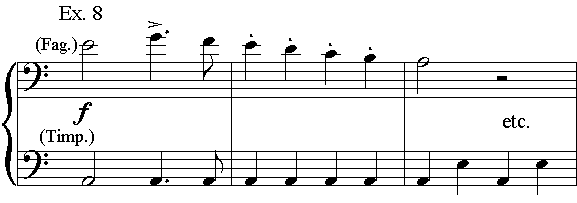


The scene changes to Cellini’s foundry in the Coliseum for the final scene, which was again longer in its pristine form. The additional music constantly amplifies the characters of Fieramosca and Balducci and accentuates Cellini’s despair when the metal runs out. At the final explosion of the cast, Cellini’s reading of the inscription on the Perseus belongs to the Weimar revision.
The original version is undeniably loose in construction and diffuse in matter. But the sequence has a logic that is frequently sacrificed in the Weimar revision, when over-compression obscured many details and created some structural anomalies. The most notable of these is Cellini’s leisure to long for a shepherd’s existence, while under the threat of death if he does not complete the statue within an hour. With a day this is more convincing, and the Pope’s two appearances are more rationally spaced.
In the belief that this early version offers as much, if not more, than the revision, the new Covent Garden production follows a lead from the Carl Rosa production of 1957 in restoring the original division of the acts, and reinstates for the first time many of the cuts and suppressions made in 1852. In addition the Pope will be restored to full dignity (if not perhaps a very dignified Pope) and references to Eminence and Monseigneur become again Très Saint Père. The use of dialogue in this new production comes from a different source, for both the 1838 and 1852 versions were sung throughout. But Berlioz’s first plan was for an opéra-comique, and certain features of that genre survived in the libretto when Berlioz and his collaborators turned to the Opéra instead. In addition the French vocal score was published with cues marking the dialogue, and a revival with dialogue, which did not in fact materialize, was planned at the Théâtre-Lyrique in l856.9
On 25 June 1853 Benvenuto Cellini was staged at Covent Garden in the presence of Queen Victoria and Prince Albert; Berlioz himself conducted. The opera was resoundingly hissed by the pro-Italian faction and immediately withdrawn, a second catastrophe for ‘mon opéra malvenu’ as Berlioz called it. Its reappearance after 113 years is both overdue and benvenuto.
Beni Montresor’s design for the opening of ‘Benvenuto
Cellini’,
in the new Covent Garden production
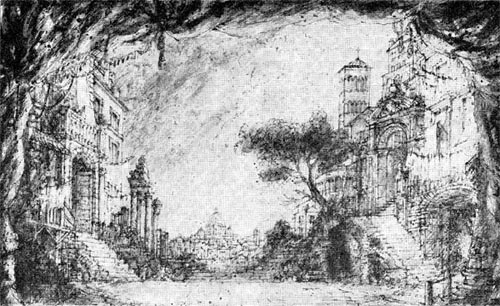
[The following image has been scanned from the programme booklet for the première of the new production of Benvento Cellini on 15 December 1966, a copy of which is in our own collection. (MT& MA)]
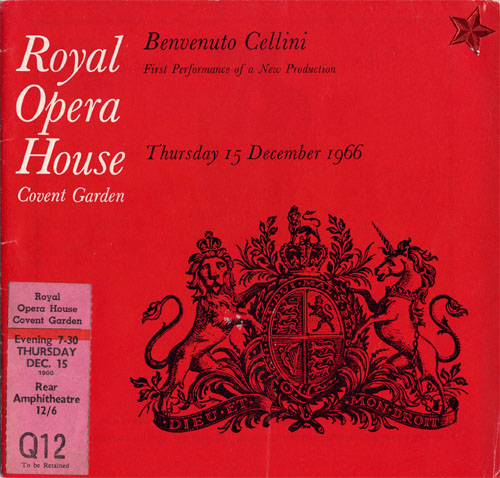
_________________
1 Tiersot, Au Milieu du Chemin, Paris 1930, p. 7![]()
2 Bibliothèque Nationale, Fonds du Conservatoire MS 1508![]()
3 ‘Les deux Benvenuto Cellini
de Berlioz’, Zeitschrift der
Internazionalen Musikgesellschaft, April-June 1913, p. 449-60![]()
4
‘Berlioziana’, Le Ménestrel, 1905, pp. 45-212![]()
5 AJ XIII 203 (574)![]()
6 Archives Nationales F21 969![]()
7 References are to the Choudens vocal score![]()
8 Tiersot, Les Années Romantiques, Paris 1904, p. 393![]()
9 See Berlioz, Briefe an die Fürstin Carolyne Sayn-Wittgenstein,
Leipzig 1903, p. 41![]()
![]()
* We are most grateful to Hugh Macdonald for
granting us permission to reproduce this article on this page.
We have transcribed the text of the article from The
Musical Times, December 1966, a copy of which is in our collection. We have not been able to contact the
editor of The Musical Times, which has ceased
publication.![]()
![]()
The Hector Berlioz Website was created by Monir Tayeb and Michel Austin on 18 July 1997; this page created on 1 April 2012.
© Monir Tayeb and Michel Austin. All rights reserved.
![]() Back to Berlioz: Pioneers and Champions
Back to Berlioz: Pioneers and Champions
![]() Back to Original Contributions page
Back to Original Contributions page
![]() Back to Home Page
Back to Home Page
![]() Retour à la page Berlioz: Pionniers et
Partisans
Retour à la page Berlioz: Pionniers et
Partisans
![]() Retour à la page
Contributions originales
à ce site et autres articles
Retour à la page
Contributions originales
à ce site et autres articles
![]() Retour à la Page d’accueil
Retour à la Page d’accueil